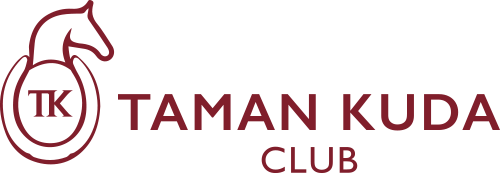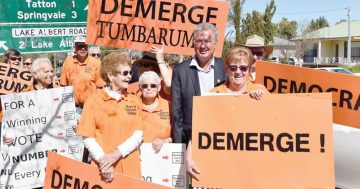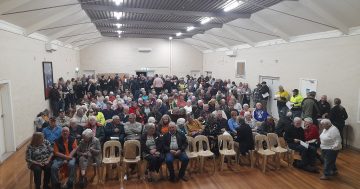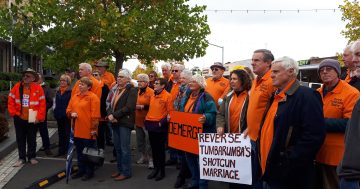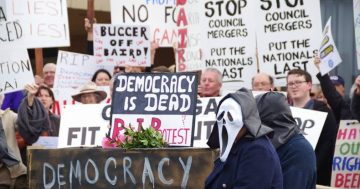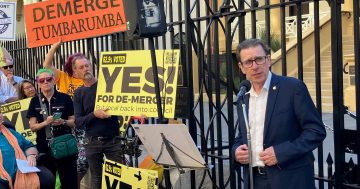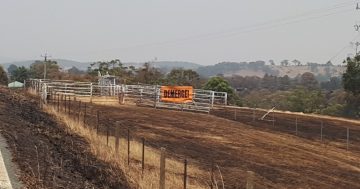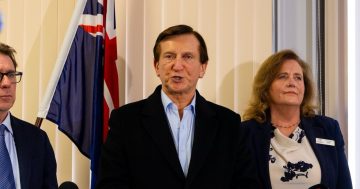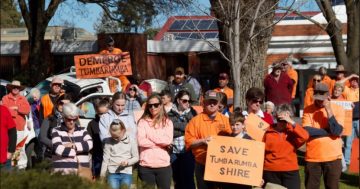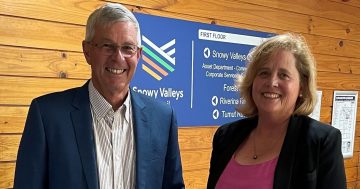
Save Tumbarumba Shire’s “Orange Army” have long campaigned against the forced merger of Tumut and Tumbarumba councils, which became Snowy Valleys Council in 2016. Photo: Save Tumbarumba Shire.
In November, residents of the Snowy Valleys local government area will go to the polls to decide whether their council should revert back to the former Tumut and Tumbarumba shires.
Last week, the NSW Electoral Commission confirmed 29 November as the date for the Snowy Valleys de-amalgamation referendum.
It’s being hailed as a landmark moment in local democracy with the outcome having the potential to see the first de-amalgamation of a local council under new NSW legislation.
The referendum question is simple: “Should the Snowy Valleys Council be de-amalgamated and the former Tumut Shire and Tumbarumba Shire councils be reconstituted as separate local government areas?”
Voting is compulsory, and for the demerger to proceed, a majority of all enrolled voters – 51 per cent – across the Snowy Valleys LGA must vote “Yes”.
But residents have been warned that splitting the council comes with considerable costs.
The NSW Local Government Boundaries Commission (NSW LGBC) estimates that de-amalgamating Snowy Valleys Council would cost more than $4.8 million in transition expenses.
Re-establishing Tumut Shire is projected to cost $1.414 million, while Tumbarumba Shire would require around $932,000 to cover administrative restructuring, asset division and establishment of separate governance frameworks for the two councils.
The commission also forecasts significant financial impacts on residents.
Rates in Tumut could rise by nearly 15 per cent over seven years, while Tumbarumba could see increases between 45 and 65 per cent with additional charges for water, sewerage, leases and licences also expected.
Any government financial support for the demerger would only be considered if a majority vote in favour of de-amalgamation is achieved in the referendum.
NSW Local Government Minister Ron Hoenig said voters must understand these impacts before casting their ballots.
“If there is majority support in the referendum and residents are prepared to accept the financial costs, then the council can progress with the transition work required to demerge,” he said. “If the referendum is rejected, the community and the council must respect that outcome and get on with it.
“The important thing is the communities of Snowy Valleys are given the choice to make this decision for themselves – not have it made for them by the State Government which has no mandate to interfere with local democracy,” Mr Hoenig said.
Snowy Valleys Mayor Julia Ham has welcomed the announcement, describing it as the first real opportunity for residents to determine their own future.
“It’s not going to be easy,” she said, “but we’re pleased to see a democratic process going forward.”
She also acknowledged the persistence of local campaigners, including the Save Tumbarumba Shire group, who have been calling for a demerger since well before Snowy Valleys Council was formed in 2016.
But not everyone believes the process is fair, including Doug Gee, a spokesperson for Save Tumbarumba Shire, who told About Regional in May that the referendum structure disadvantages smaller communities.
“It doesn’t give any voice to small towns like ours,” he said. “We’re a very small part of the population, so even if every Tumbarumba resident votes yes, it might not be enough.”
Similar concerns have been voiced in Adelong, where some residents say they feel overlooked by Tumut and would prefer not to be part of a re-formed Tumut Shire.
For many locals, the vote is about more than finances.
Reports in the Daily Telegraph and Tumut and Adelong Times have documented years of staff turnover, internal conflict and morale issues linked to the merger.
Some residents argue the council has struggled under the amalgamation, while others believe it has finally found its footing and that splitting again could waste resources.
The history of the merger helps explain why the vote has stirred strong feelings.
Snowy Valleys Council was created in May 2016 when the Liberal-National government forcibly merged Tumut and Tumbarumba shires as part of a statewide local government reform program.
Controversial from the outset, many residents argued the merger disrupted long-standing governance structures, reduced local representation and left Tumbarumba and other smaller communities disadvantaged.
Organised community campaigns saw residents from across the Snowy Valleys, often dressed in bright orange, travel to Sydney to protest outside NSW Parliament.
The demonstrations were a vivid expression of local frustration, with participants joined by their neighbouring counterparts from the equally incensed Cootamundra-Gundagai Regional Council, calling on the State Government to listen to their concerns and reverse what they described as a damaging and unpopular amalgamation.
In July 2021, then-NSW Minister for Local Government Shelley Hancock declined Snowy Valleys Council’s request to demerge, despite a recommendation from the NSW LGBC to proceed.
When Labor came to power in April 2023, it would, 10 months later, introduce legislation allowing councils to pursue de-amalgamation through a local referendum, provided a business case demonstrated financial viability and community support.
Snowy Valleys Council was among the first to take that step, preparing a business case, implementation plan and financial sustainability assessment reviewed by the LGBC.
Public hearings and consultation helped shape the commission’s recommendations, which were supported by the minister.
“The impact the amalgamation continues to have on the council, councillors and staff was made clear by the Boundaries Commission,” Mr Hoenig said when he greenlit the referendum.
In the lead-up to November, debate is expected to intensify.
For now, residents are being asked to examine the plans, attend information sessions and consider the trade-offs of de-amalgamation.
This information is contained on the Office of Local Government website under Current Proposals.
Save Tumbarumba Shire’s website and Facebook page also serve as a hub for information about the referendum process, the financial and community case for de-amalgamation and updates on the group’s activities.
Snowy Valleys Council will also provide updates via its website as well as the Snowy Valleys Council Facebook page.
The Snowy Valleys de-amalgamation referendum will be conducted by the NSW Electoral Commission.
For information about the referendum, or to check and update your enrolment details, visit the NSW Electoral Commission website.





